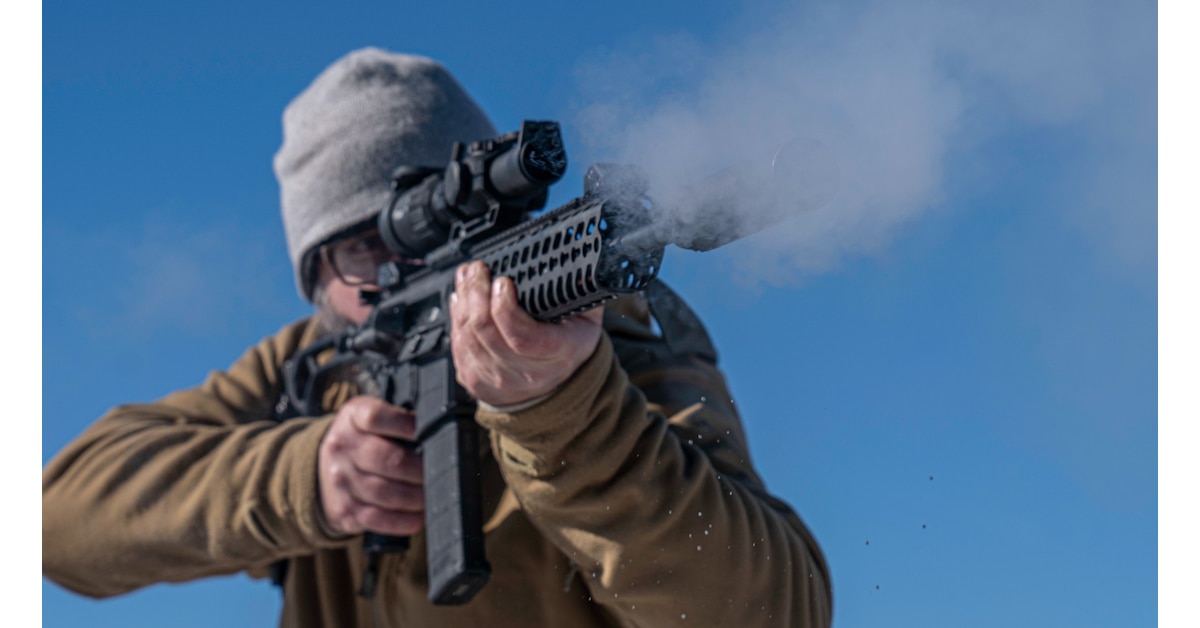
Dawn of Modern Sporting Rifles
SIG Sauer’s MCX design did away with the buffer tube and spring and replaced it with a spring system inside the upper receiver. (Photo: Jeff Wood/Guns.com)
Since the first Stoner variant of the AR-15, a buffer tube protruding from the rear of the lower receiver has long been common place. The buffer tube serves two purposes. First, it houses the buffer and spring, which are vital parts of the function of the action. Second, it serves as the base structure for the buttstock of the firearm. Buttstocks are typically attached around or to the buffer tube itself, which has dominated the design of all the various available buttstocks for AR-patterned rifles.
That new design means the MCX bolt can run without the addition of a buffer tube/stock as well. (Photo: Jeff Wood/Guns.com)
The design of the MCX migrated the buffer spring and its associated hardware into the upper receiver. In doing so, it has changed several aspects of the platform itself. Gone are the days of fitting your buttstock to the tube, in fact, you don’t even need a stock with the MCX. There are “pistol” configurations that don’t even use a buttstock.
This tubeless design makes the MCX stand out from the AR crowd, but there is more to this gun than just the buttstock.
Diving Deeper Into the MCX
The MCX shares a great many of parts with most AR-style rifles. Magazines, triggers, and such are compatible, but there are also plenty of differences. The bolt carrier in the MCX is driven forward by a pair of springs that ride just above the carrier inside the receiver. The charging handle also sandwiches into the same area as the recoil springs and bolt carrier.
The lower receiver remains very similar to the AR design, even accepting AR pattern mags. But it also brings an extra magazine release on the left side and a small spring plunder behind the trigger that appears to reduce the play between the upper and lower receiver. (Photo: Jeff Wood/Guns.com)
The handguard is attached to the upper receiver and features a very skeletonized KeyMod attachment section. Newer models also have M-Lok-compatible handguards. There is a small window in the front of the handguard to access the two-position gas valve.
The lower receiver is very similar to traditional AR lowers except where the buttstock attaches. Additionally, it features an extra magazine release on the left side of the receiver. There is also a small spring plunger mounted behind the trigger that appears to be an accurizing add-on to reduce the play between upper and lower receivers.
The buttstock itself is a skeletonized design with a built-in folding hinge, allowing the stock to be stowed to the side of the rifle. This, of course, doesn’t affect the operation of the rifle. All the mechanics of the operating system are contained within the receivers, so the rifle can fire regardless of the stock position.
RangeTime
Hitting the range, the gun handles recoil easily, and the three-pronged flash hider works well. (Photo: Jeff Wood/Guns.com)
As soon as I could, I prepared the MCX for the range. I mounted up a fresh Tango MSR scope, also from SIG Sauer. The 1-8x power scope would be an excellent complement to the MCX. I then grabbed a suppressor because I wanted to see how the rifle functioned suppressed. I packed up some PMC X-Tac 55-grain ball ammo to shoot in the rifle as well as a Magpul MS4 sling. Finally, I added a couple of assorted PMags and GI magazines to try in the rifle.
After bore sighting the scope, I cracked off the first few rounds, and they were quite close to my point of aim. It only took minor adjustments to get the scope zeroed, and then it was go time. Shooting the rifle at 100 yards, I quickly gained familiarity with both the rifle and scope. Hits came easily as the MCX churned away smoothly. The weight felt surprisingly light. I believe they were advertised at 6 pounds, though I think that is a little under what this one weighed naked.
The rifle also feels light in the hand and wields well. (Photo: Jeff Wood/Guns.com)
The three-pronged flash hider seemed very effective at reducing muzzle flash, and the recoil of the 5.56 cartridge is very easy to handle in a rifle this size. The rifle was very comfortable in maneuvering and made for a very enjoyable time shooting. I stretched the rifle out to the 300-yard line, where I found it to be still quite accurate. I imagine a wondering coyote that might have wandered into range would have been easily dispatched. Both PMags and GI metal mags functioned flawlessly, as I would expect from this rifle.
going quiet

After having some fun with the rifle in loud mode, I figured it was time to install my suppressor to see how the rifle performed suppressed. This required removing the factory flash hider and installing my suppressor mount. SIG uses a taper on many of its muzzle devices to aid in alignment, since I wasn’t using a SIG suppressor, the taper was unneeded. I mounted up my Yankee Hill Machine Turbo 5.56 suppressor and went right back to town on the targets.
Suppressed shooting made the MCX really shine. The increased weight seemed to calm down the recoil impulse even further, making it easy enough to spot my own hits at 200 yards. The reduced noise is always welcome, and hearing steel targets ring without hearing protection is always better.
Accuracy
Under better conditions, the gun should provide even better groups. (Photo: Jeff Wood/Guns.com)
Accuracy shown here from the MCX wasn’t spectacular, but I can certainly explain that. The included picture shows five shots from 55-grain PMC X-Tac ammunition. It shot much better with Hornady Black 75-grain match, but I didn’t get it on paper. Shooting from bags at 100 yards with an eight-power scope while shivering in below freezing temps may not have given the MCX a fair shake.
Pros & Cons











